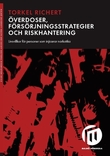mat:dok lärosäte:mau år:(2014)
Sökning: mat:dok lärosäte:mau år:(2014) > Överdoser, försörjn...
- 21 av 29
- Föregående post
- Nästa post
- Till träfflistan
Överdoser, försörjningsstrategier och riskhantering : livsvillkor för personer som injicerar narkotika
-
- Richert, Torkel (författare)
- Malmö högskola,Institutionen för socialt arbete (SA)
- (creator_code:org_t)
- ISBN 9789171046093
- Malmö högskola, Hälsa och samhälle, 2014
- Svenska 190 s.
- Serie: Malmö University Health and Society Dissertations, 1653-5383 ; 5
- Doktorsavhandling (övrigt vetenskapligt/konstnärligt)
Abstract
Ämnesord
Stäng
- People who inject illegal drugs constitute a vulnerable group in society. Their vulnerability can partly be explained by the negative consequences of the drug use itself and the particular risks associated with injecting, but also by society’s negative view of, and harsh attitude towards, drug users. Injection drug use is a relatively understudied topic in Sweden. The overall aim of this dissertation is to examine life circumstances of people who inject heroin or amphetamines. The dissertation is based on two research projects at Malmö University and includes interviews with a total of over two hundred visitors at the needle exchange program in Malmö as well as focus group discussions with twenty-seven heroin users in treatment. The first project focus on women who use the needle exchange program and on their social situation, income strategies, experience of treatment and care, as well as on their wishes for further societal assistance. The results present a picture of a very heterogeneous group of women, in which most differ from the stereotypical image of the female injection drug user as homeless, destitute, marginalized, and primarily dependent on men or prostitution for their livelihood and access to drugs. Most women were active in the drug economy, they obtained most of the drugs they used on their own, and they supported their drug purchases through both formal and informal sources of income. A small group, mainly women who primarily use heroin, described a very vulnerable and marginalized existence with insecure housing and incomes restricted to dealing, stealing or sex-work. The vast majority of the interviewed women did wish for some sort of societal support in order to change their situation. Most requests involved substance abuse treatment. More than anything, heroin users wished for better access to opioid substitution treatment. Many women also wanted access to women-only treatment facilities. Not all women, though, saw their drug use as problematic or intended to stop using illegal drugs. Some saw society’s poor treatment of drug users and the “repressive” drug policy as a greater problem than the drug use itself. The second research project focus on heroin overdoses. The aim of the project was to gain further knowledge on why overdoses occur, a greater understanding of how heroin users interpret and handle the overdoses of others, as well as to discuss potential interventions to reduce the number of overdose deaths in Sweden. The results showed that the interviewed heroin users generally had good knowledge about overdose risks. Different circumstances, however, caused restricted possibilities to avoid overdose risks or meant that risks were seen as minor compared to the potential gains of drug use. The desire for a powerful high, experience of severe withdrawal symptoms, an unsafe environment, mental ill health, and an “unbearable life situation”, were examples of factors associated with an increased risk of overdoses. Those heroin users who had been present at someone else’s overdose generally had a positive attitude towards assisting the victim, and their actions were often life-saving. However, a number of factors such as the witness’s own intoxication or lack of knowledge of lifesaving measures, as well as fear of police involvement in some cases, led to inadequate responses to overdoses. The interviewees’ accounts point to the need for a more diverse and accessible drug abuse and addiction treatment model but also to the need for interventions that aim to reduce vulnerability and improve life circumstances and health for persons who, for various reasons, continue to use illegal drugs. The results also reveal the need for interventions that improve heroin users’ possibilities for safer drug use, as well as the importance of increasing their potential for helping other heroin users who overdose.
Nyckelord
- injecting drug use
- heroin
- amphetamine
- risk taking
- overdose
- women drug users
- social vulnerability
- harm reduction
Publikations- och innehållstyp
- vet (ämneskategori)
- dok (ämneskategori)
Hitta via bibliotek
- Överdoser, försörjningsstrategier och riskhantering livsvillkor för personer som... (Sök publikationen i LIBRIS)
Till lärosätets databas
- 21 av 29
- Föregående post
- Nästa post
- Till träfflistan
Hitta mer i SwePub
- Av författaren/redakt...
- Richert, Torkel
- Delar i serien
- Malmö University ...
- Av lärosätet
- Malmö universitet
Sök utanför SwePub
- Sök vidare i:
- Google Book Search
- Google Scholar
Kungliga biblioteket hanterar dina personuppgifter i enlighet med EU:s dataskyddsförordning (2018), GDPR. Läs mer om hur det funkar här.
Så här hanterar KB dina uppgifter vid användning av denna tjänst.
- Copyright © LIBRIS - Nationella bibliotekssystem
- LIBRIS.kb.se

